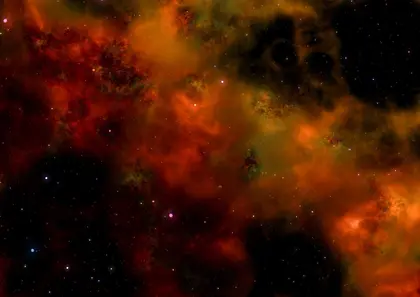Washington, DC—A new paper from an interdisciplinary team led by Carnegie’s Michael Wong and Robert Hazen explores the idea of increasing complexity in natural systems through the lens of evolution. Their work, published by Proceedings of the National Academy of Sciences hypothesizes the existence of “a missing law of nature.”
Their work proposes that complex natural systems evolve to states of greater patterning, diversity, and complexity. In other words, they say that evolution is not limited to life on Earth, it also occurs in other massively complex systems, from planets and stars to atoms, minerals, and more.
Authored by a nine-member team—scientists from Carnegie, Caltech, and Cornell University, and philosophers from the University of Colorado—the work was funded by the John Templeton Foundation.
“Macroscopic” laws of nature describe and explain phenomena experienced daily in the natural world. Natural laws related to forces and motion, gravity, electromagnetism, and energy, for example, were described more than 150 years ago.
The new work presents a modern addition—a proposed macroscopic law recognizing evolution as a common feature of the natural world’s complex systems, which are characterized as follows:
- They are formed from many different components, such as atoms, molecules, or cells, that can be arranged and rearranged repeatedly;
- Are subject to natural processes that cause countless different arrangements to be formed;
- Only a small fraction of all these configurations survives in a process called “selection for function.”
Regardless of whether the system is living or nonliving, when a novel configuration works well and function improves, evolution occurs, the authors say, adding that the system will evolve “if many different configurations of the system undergo selection for one or more functions.”
“An important component of this proposed natural law is the idea of ‘selection for function,’” said first author Wong.
In the case of biology, Darwin equated function primarily with survival—the ability to live long enough to produce fertile offspring. The new study expands that perspective, noting that at least three kinds of function occur in nature.
The most basic function is stability—stable arrangements of atoms or molecules are “selected” to continue. Also chosen to persist are dynamic systems with ongoing supplies of energy. The third and most interesting function is “novelty”—the tendency of evolving systems to explore new configurations that sometimes lead to startling new behaviors or characteristics.
Life's evolutionary history is rich with novelties—photosynthesis evolved when single cells learned to harness light energy, multicellular life evolved when cells learned to cooperate, and species evolved thanks to advantageous new behaviors such as swimming, walking, flying, and thinking.
The same sort of evolution happens in the mineral kingdom. The earliest minerals represent particularly stable arrangements of atoms. Those primordial minerals provided foundations for the next generations of minerals, which participated in life’s origins. The evolution of life and minerals are intertwined, as life uses minerals for shells, teeth, and bones.
Indeed, Earth’s minerals, which began with about 20 at the dawn of our Solar System, now number almost 6,000 known today thanks to ever more complex physical, chemical, and ultimately biological processes over 4.5 billion years.
In the case of stars, the paper notes that just two major elements—hydrogen and helium—formed the first stars shortly after the big bang. Those earliest stars used hydrogen and helium to make about 20 heavier chemical elements. And the next generation of stars built on that diversity to produce almost 100 more elements.

“Charles Darwin eloquently articulated the way plants and animals evolve by natural selection, with many variations and traits of individuals and many different configurations,” said Hazen, a longtime research leader in this area. “We contend that Darwinian theory is just a very special, very important case within a far larger natural phenomenon. The notion that selection for function drives evolution applies equally to stars, atoms, minerals, and many other conceptually equivalent situations where many configurations are subjected to selective pressure.”
The co-authors themselves represent a unique multi-disciplinary configuration: three philosophers of science, two astrobiologists, a data scientist, a mineralogist, and a theoretical physicist.
Wong adds: “In this new paper, we consider evolution in the broadest sense—change over time—which subsumes Darwinian evolution based upon the particulars of ‘descent with modification. The universe generates novel combinations of atoms, molecules, cells, etc. Those combinations that are stable and can go on to engender even more novelty will continue to evolve. This is what makes life the most striking example of evolution, but evolution is everywhere.”
Among many implications, the paper offers:
- Understanding of how differing systems possess varying degrees to which they can continue to evolve. “Potential complexity” or “future complexity” have been proposed as metrics of how much more complex an evolving system might become.
- Insights into how the rate of evolution of some systems can be influenced artificially. The notion of functional information suggests that the rate of evolution in a system might be increased in at least three ways: (1) by increasing the number and/or diversity of interacting agents, (2) by increasing the number of different configurations of the system; and/or 3) by enhancing the selective pressure on the system (for example, in chemical systems by more frequent cycles of heating/cooling or wetting/drying).
- A deeper understanding of generative forces behind the creation and existence of complex phenomena in the universe, and the role of information in describing them.
- An understanding of life in the context of other complex evolving systems. Life shares certain conceptual equivalencies with other complex evolving systems, but the authors point to a future research direction, asking if there is something distinct about how life processes information on functionality.
Aiding the search for life elsewhere: if there is a demarcation between life and non-life that has to do with selection for function, can we identify the "rules of life" that allow us to discriminate that biotic dividing line in astrobiological investigations?
